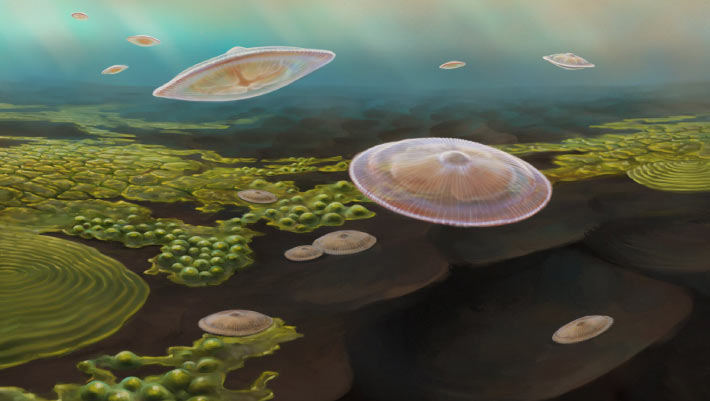Until now, scientists broadly accepted complex life forms first emerged on Earth around 635 million years ago (Ediacaran period). But an international team of paleontologists from Cardiff University, the Université de Toulouse, the Université de Poitiers and China Nonferrous Metals (Guilin) Geology and Mining Co. Ltd discovered evidence of a much earlier ecosystem in the Franceville basin near Gabon on the Atlantic coast of Central Africa over 1.5 billion years earlier.
An artist’s impression of the lobate macrofossils living 2.1 billion years ago in a shallow marine inland sea created by the collision of two continents. Image credit: Abderrazzak El Albani, University of Poitiers.
“The availability of phosphorus in the environment is thought to be a key component in the evolution of life on Earth, especially in the transition from simple single cell organisms to complex organisms like animals and plants,” said Cardiff University’s Dr. Ernest Chi Fru.
“We already know that increases in marine phosphorus and seawater oxygen concentrations are linked to an episode of biological evolution around 635 million years ago.”
“Our study adds another, much earlier episode into the record, 2.1 billion years ago.”
Scientists have widely debated the validity of large-sized fossils of macroorganisms from the Ediacaran period, which are the earliest of their kind in the geologic record.
But Dr. Chi Fru and his colleagues identified a link between environmental change and nutrient enrichment prior to their emergence which might have triggered their evolution.
Their geochemical analysis of the marine sedimentary rocks deposited 2.1 billion years ago sheds new light on this much-disputed body of unusually large size fossils in the Francevillian basin.
The 2.1-billion-year-old lobate macrofossils from the Franceville basin. Image credit: Abderrazzak El Albani, University of Poitiers.
“We think that the underwater volcanoes, which followed the collision and suturing of the Congo and São Francisco cratons into one main body, further restricted and even cut off this section of water from the global ocean to create a nutrient-rich shallow marine inland sea,” Dr. Chi Fru said.
“This created a localized environment where cyanobacterial photosynthesis was abundant for an extended period of time, leading to the oxygenation of local seawater and the generation of a large food resource.”
“This would have provided sufficient energy to promote increase in body size and greater complex behavior observed in primitive simple animal-like life forms such as those found in the fossils from this period.”
However, the restricted nature of this water mass, together with the hostile conditions that existed beyond the bounds of this environment for billions of years later, likely prevented these enigmatic life forms from taking a global foothold.
The study suggests that these observations may point to a two-step evolution of complex life on Earth.
Step one followed the first major rise in atmospheric oxygen content 2.1 billion years ago and step two followed a second rise in atmospheric oxygen levels some 1.5 billion years later.
“While the first attempt failed to spread, the second went on to create the animal biodiversity we see on Earth today,” Dr. Chi Fru said.
The results were published in the journal Precambrian Research.
_____
Ernest Chi Fru et al. 2024. Hydrothermal seawater eutrophication triggered local macrobiological experimentation in the 2100 Ma Paleoproterozoic Francevillian sub-basin. Precambrian Research 409: 107453; doi: 10.1016/j.precamres.2024.107453

